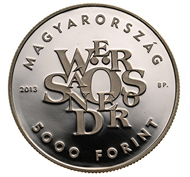July 4, 2013 – In celebration of the 100th anniversary of the birth of Sándor Weöres, the Magyar Nemzeti Bank is issuing a silver commemorative coin in the series “Great Figures in Hungarian Literature” and as part of the international collector’s series “Europe”. The unconventional playfulness of Sándor Weöres was captured by the metal artist Zoltán Tóth.
Hungary / 5,000 HUF / silver .925 / 34 mm / 20 g / Design: Zoltán Tóth / Mintage: 5,000.
Born into an educated middle-class family in Szombathely, Sándor Weöres (1913-1989) was a poet, writer, literary translator and scholar, today considered to be one of the outstanding figures in Hungarian literary history. At the age of 15, his first writings were published in the periodical “Hír”. He studied law and then geography and history at the university in Pécs, later receiving a doctorate in philosophy and aesthetics. His first collection of poems “Hideg van” (It is cold) was published in 1934.
In 1936, he received the highest literary prize at the time, the Baumgarten Award, the proceeds of which allowed him to travel to Northern Europe and then to the Far East. He received his doctorate in 1939, and his dissertation “The Birth of the Poem” was published in the university periodical “Pannónia”. From 1941 he worked as a librarian, first in Pécs and then from 1943 at the National Széchényi Library in Budapest. For a brief period he also worked in a museum in Székesfehérvár. In 1947 he married the poet Amy Károlyi, with whom he spent almost a year in Italy. Upon returning to Hungary, he was employed at the library of the Hungarian Academy of Sciences.
From 1949, he was excluded from Hungary’s official literature policy, and only his literary translations and children’s poetry was allowed to be published. He was fired from his job at the library in 1951. He returned to the public stage in 1956, with a collection of poems entitled “A hallgatás tornya” (The Tower of Silence), and then with his collected translations “A lélek idézése” (The Conjuring of the Soul). In 1959 he travelled extensively with his wife in China.
In celebration of his 50th birthday, the periodical Magyar Mühely in Paris published a special edition. His work “Tüzkút” (Firewell) was first published in Paris and then later in Hungary. He received the prestigious Kossuth Award in 1970, using the prize money to found the Béla Pásztor Award for young poets. Published in 1972, his lyrical novel “Pszyché” was a great success, summarising the spiritual adventures of an enlightened female poet in the 19th century, with a perfect command of the language of that period. He received the Austrian State Prize for European Literature in 1974.
His extraordinarily productive life also included theatre pieces and powerful translations. His collected works were published in three volumes in 1981, highlighting his fantastic, playful approach to poetry as reflected in the myriad of forms and in the images of antique mythology and modern-day life which can be interpreted in many ways. His imagery and mode of expression bring to mind the natural innocence of a child, bordering on the surreal, the grotesque and the absurd at times. His unique use of rhyme and rhythm broadened the horizons of Hungarian poetry.
For younger generations in Hungary, their first real exposure to literature often comes from his works such as “Bóbita” (1955) and “Ha a világ rigó lenne” (1974). Nowadays, it is hard to find anyone in Hungary who was not brought up reading his poetry.
For more information about the Hungarian Mint, please click here.






